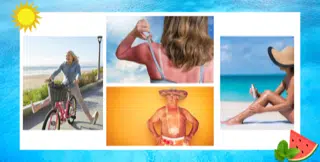Who doesn’t love a beautiful summer day? Warm, sunny weather makes that morning walk, bike ride or daily exercise even more enjoyable. People flock to beaches and swimming pools to soak up the rays of the sun and doing so provides so many positive benefits. The sun enhances our mood and energizes us, treats seasonal affective disorder, relieves stress, improves sleep and increases production of vitamin D. But with all these positive benefits of the sun, there are negative effects we should all stay aware of. Unprotected or too much exposure to UV (ultra-violet) rays can damage your eyes and cause heat exhaustion, heat stroke, sunburn, heat rash, wrinkles and skin cancer.
Heat stroke and heat exhaustion can both result in a fast or weak pulse, headache, dizziness, nausea or loss of consciousness. Skin may be hot, red, dry or even damp with heat stroke but typically skin will be clammy with heat exhaustion. If there is a high body temperature (over 103°), heat stroke is the more likely cause and 9-1-1 should be called immediately. When heat stroke or heat exhaustion is suspected, the person should be moved out of the sun and a bath or cool cloth can be used to lower their body temperature. Believe it or not, in Traditional Chinese Medicine, the “go to herb” to prevent heat stroke and exhaustion is watermelon. Watermelon contains high water content and natural sugars that help regulate the body. Mint is also a very popular Chinese herb used to clear heat and can be added to lemonade or water.
UV rays are an invisible form of radiation that comes from the sun in varying wavelengths. UVB rays have shorter wavelengths and pose the greater risk of skin cancer. UVA rays have longer wavelengths that cause aging and wrinkles, but also increase the damaging effects of UVB rays. Choosing the right sunscreen is important because it can help protect against skin damage from UV rays. Look for sunscreen that provides broad spectrum protection, meaning that it protects against damage from both UVA and UVB rays. Choose a sunscreen with an SPF of 30 or higher and is water-resistant. Reapply sunscreen at least every 2 hours and after coming out of the water. Finally, discard sunscreen after 1-2 years because it starts to lose its effectiveness.
Fun fact: one shot glass full of sunscreen (one ounce) is what you need to cover the parts of your body exposed to the sun. It is also recommended to apply sunscreen while indoors at least 20-30 minutes prior to sun exposure.
Sunburn is the price we pay for an otherwise fun day spent in the sun when adequate precautions haven’t been taken. We can’t always tell that we’re getting sunburned until after we get home. Symptoms of sunburn include red skin, blisters (with serious sunburn), headache, fever and fatigue. To help alleviate sunburn, take aspirin, acetaminophen or ibuprofen and drink plenty of water. Use aloe or an after-sun moisturizing cream to soothe burned skin and stay out of the sun until the symptoms subside.
Skin cancer is the most common form of cancer in the United States. Types of skin cancer include basal cell carcinoma, squamous cell carcinoma and melanoma. Regularly check your skin for moles that are not symmetrical or have irregular borders, are bigger than a pencil eraser, are itchy or painful, bleed or are new. Schedule visits with your dermatologist to identify skin conditions early.
It’s important to have fun outside but do it safely. Always wear sunscreen and apply it to all parts of your body exposed to the sun. Wear a wide-brimmed hat and don’t forget sunglasses for your eyes. They can also become sunburned and prolonged exposure can cause damage. Use umbrellas and tents to minimize sun exposure, drink lots of water and eat that watermelon!
“Sun protection doesn’t need to be complicated or expensive – it needs to be consistent.” – Hillary Fogelson

